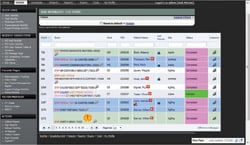
Increasing procedure volume, brought on by pending healthcare reforms, may put a premium on software that can automate and streamline workflow. (Screenshot of Synapse RIS 6.2 courtesy of FujiFilm Medical Systems)
In the 1970s when I studied at the University of Wisconsin-Madison, the UW had a reputation for being a hotbed of insurrection. I did my part in 1975 by wearing Gerald Ford’s WIN button upside down. It was a tacit repudiation of the idea that a public relations campaign could spawn a grassroots movement to “Whip Inflation Now” and an implied statement that there are “No Immediate Miracles.”
Forty years later, there is a consensus in the radiology community that government efforts cannot produce miracles, at least anytime soon. At November’s RSNA meeting, executives of major equipment vendors told me they had all but given up hope that the current recession would soon end. Over the next 18 to 24 months, the new normal for the imaging community, they said, would be comprised of sporadic gusts of purchasing followed by long periods of little upbeat activity.
Regents Health Resources, a national consulting firm specializing in medical imaging business intelligence, suggests otherwise.
Regents estimates that the Patient Protection and Affordable Care Act (PPACA) will lead providers to perform millions more imaging exams. Californians alone could undergo almost 9 million additional imaging exams per year. Across the country, imaging procedures are forecast to rise an average 13.6 percent. This would translate into 61 million more such procedures annually.
You might say, “Hallelujah, brother … and pass the mustard.” But hold on. As with my diminution of President Ford’s attack on inflation, we would all do well to don our NIM buttons. There are no immediate miracles!
The radiology climate is not likely to turn suddenly from Ice Age to Jurassic. Considering, however, that a government program designed to substantially broaden insurance coverage has the potential to change, over time, the healthcare landscape, the imaging community might consider how this landscape could change if healthcare reform exerts a cumulative influence over the coming years.
If procedure volumes rise, as Regents predicts, it would eventually absorb the over-capacity that now exists in some imaging operations. This would lead some facilities to extend their hours of service to handle the increased load in the short-term, as they plan changes
in technologies and staff management to foster
long-term fixes.
Meanwhile, there would likely be a growing cry from budgeteers. Regents forecasts that additional procedures will add $4 billion to Medicare and Medicaid expenses in just the six states experiencing the biggest surge in demand — California, Florida, Massachusetts, New York, Tennessee and Texas. The rest of the country would add to that, undoing years of reduced expenditures in medical imaging orchestrated by last decade’s Deficit Reduction Act.
If this happens, radiology could again be vilified for adding cost to healthcare. The real risk to radiology, however, might come from short-term answers
inappropriately applied by referring physicians who order the wrong exams and the docs who do their own imaging. Low-cost substitutes may be wedged into places where higher cost, premium performance technologies belong, resulting in misdiagnoses and substandard care that could smear medical imaging.
To date, organized radiology has failed to get across to the general public the value that imaging brings to patient management. In the months and years ahead, we would be well served to find a way to do so or the imaging community could be seriously harmed, especially if radiology stages a miraculous comeback over the coming years.
To put this likelihood in perspective, look back to when President Ford declared that inflation was “public enemy No. 1” in a speech to Congress titled “Whip Inflation Now.” At the time, the United States was struggling with annual inflation of 11.3 percent, according to the Bureau of Labor Statistics. Two years later, that rate had dropped to 5.8 percent.
While miracles did not immediately happen, one did indeed happen. In that context, it would be wise for us to not write off the imaging industry, but rather to prepare for the best. Because unless we are careful, the best could all too easily turn into the worst.
Greg Freiherr has reported on developments in radiology since 1983. He runs the consulting service, The Freiherr Group. Read more of his views on his blog at www.itnonline.com.


 April 17, 2024
April 17, 2024 








